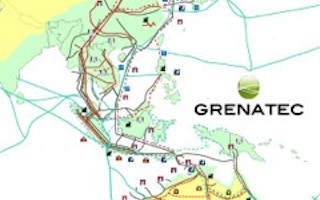By 2050, Southeast Asia could lie at the center of Asia’s ‘clean energy revolution.’
By that year, Southeast Asia could be the transit route for a Pan-Asian Energy Infrastructure stretching from China to Australia. This infrastructure would include natural gas pipelines, high voltage power lines and fiber optics cables — all bundled together.
The result would be a kind of Asian ‘internet’ of energy.
The positive ramifications of an open-access, common carrier Asian energy infrastructure are hard to overstate. The rudiments of the system are already taking shape.
Grenatec’s vision of a connected Asian energy grid.
In the Association of Southeast Asian Nations (Asean), there are plans to deepen interconnections between the 10-member nations’ electricity grids and natural gas pipeline networks.
These two efforts are called, respectively the Trans-Asean Electricity Grid and the Trans-Asean Gas Pipeline. They lead the world in tackling the technical, economic and political hurdles to deepening multilateral energy trade and fuel substitution.
Deeper, more integrated networks enable new energy resources to be developed and delivered. This encourages innovation, lowers prices and increases supply security.
A Pan-Asian Energy Infrastructure built around open-access transport, competitive multilateral markets and carbon-adjusted pricing will represent a dramatic reform. It will yield dramatic benefits. Over the past 20 years, similar reforms have transformed the hidebound, oligopolistic global telecommunications industry into a highly competitive, innovative business.
In Asia, the timing is perfect. The region is at the beginning of a major infrastructure construction boom. According to the Asian Development Bank (ADB), ‘Asia’ (i.e Japan, South Korea, China, the Asean states, East Timor, Papua New Guinea and Australia) needs trillions of dollars of infrastructure investment in coming years.
This needed investment includes everything from roads and rail to power lines, natural gas infrastructure and fiber optics links. As this is built out, all countries will gain from greater coordination to ensure interconnectivity and common standards.
A frictionless Asian energy and information transport infrastructure will unleash hugely positive change. Consider the possibilities:
Some of Earth’s strongest sunlight falls on Australia’s massive and underpopulated interior. Harnessing this solar energy would be sufficient to power not just Asia, but the world. Australia’s interior also has huge geothermal resources. Australia’s southern coastlines have strong wind resources.
In northern Asia, Japan has geothermal energy. South Korea has tidal energy. Northern China also has wind and solar energy.
All these resources are ‘stranded’ without a transmission infrastructure to bring them to market. If a Pan-Asian Energy Infrastructure were built, the energy and the information to manage it could flow up and down the hemisphere.
Surplus solar energy generated from Australia’s interior could be transmitted northward to Southeast Asia and China through low-loss, long distance high capacity power lines.
Southeast Asia could develop and trade its own renewable energy sources. These include hydro, biomass, geothermal and ocean energy (ie tides, waves and ocean thermal).
Singapore could serve as the geographically-central network manager of the system.
As this network developed, an aggregated market of two billion people representing one-third of global economic output and one-third of global greenhouse gas emissions would emerge.
The marketplace would do the rest. Over time, the ideal mix of carbon-adjusted, distance-adjusted low emission energy would be developed, transmitted and consumed.
The most compelling argument in favor of such a system is that the framework is already beginning to emerge. The key now is to realise this, and work toward linking together the now disparate bits to create a whole much greater than the sum of the parts.
For instance, China is building out a network of high-capacity, long distance domestic power lines. As these are built out, deeper interconnections can be made between China, Russia and the Mekong states. Over time, China can connect its grid to that of Japan and South Korea through the East China Sea.
China is also now building out long distance natural gas pipelines to diversify imports of natural gas. These pipelines can be linked to Southeast Asia and Australia, where large new natural gas supplies are being developed.
It doesn’t stop there. China is also linking up its major cities with fiber optic cables. Indonesia is busily doing the same by stringing fiber all the way from Sumatra to Papua. Meanwhile, Australia is busily laying a universal fiber optic system connecting every home. Countless new fiber projects are either planned or underway in the South China Sea.
Virtually all of these infrastructure projects will be traversing common routes. Bundling them can save mightily on labour costs, which account for half or more of most infrastructure projects. These saved funds can be spent on rural electrification, education or improved health care — creating a virtuous circle of economic growth and social inclusion.
Battling climate change calls for dramatically new ways of thinking. This new thinking will, in many cases, involve ripping up and reforming obsolete ways of doing things.
The good news is that Asia now has a once-in-a-century blank slate upon which it can etch a new infrastructure future. If it thinks big and thinks different, the entire region could benefit, dramatically.
Stewart Taggart is the principal of Grenatec, a Sydney-based research consultancy studying the benefits and challenges involved in building out a Pan-Asian Energy Infrastructure. The organisation’s flagship research work, ‘Pan-Asian Energy Infrastructure,’ a 200-page analysis of the opportunities, is available from Grenatec’s website http://www.grenatec.com.


















